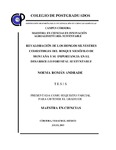| dc.description.abstract | Los hongos comestibles silvestres (HCS) son un recurso forestal no maderable de enorme importancia potencial en la conservación de las regiones forestales, por su importancia nutrimental, económica, social y cultural. Sin embargo, en el caso específico de los bosques mesófilos de montaña de México, existe una escasa valoración de este importante recurso alimentario. El presente trabajo pretende contribuir a la generación de información tendiente a la revaloración de la importancia de los hongos comestibles silvestres de los bosques mesófilos de montaña del Centro de Veracruz y su potencial en el desarrollo forestal sustentable de dicho tipo de vegetación. Se recolectaron especies de HCS en los mercados y áreas naturales de la región de estudio y se seleccionaron 7 especies de gran importancia económica, social y cultural: Amanita basii, A. jacksonii, Cantharellus odoratus, Hypomyces lactifluorum, Lactarius indigo, Russula delica y Ramaria fennica para efectuar su análisis bromatológico y nutrimental. El análisis proximal incluyó la determinación de humedad, cenizas, grasas, proteínas, fibra cruda, carbohidratos y aporte calórico; y el análisis nutrimental incluyó la determinación de vitaminas (tiamina, riboflavina, niacina y vitamina C) y minerales (Fe, K, Ca, Na, P y Se), siguiendo las metodologías publicadas por la Norma Oficial Mexicana. Se encontró que las especies de HSC evaluadas son buena fuente de proteínas, carbohidratos y poseen un bajo contenido de grasas, confirmando que el contenido nutricional es similar a otros alimentos como vegetales y carnes. Adicionalmente, algunas especies constituyen una buena fuente del complejo de vitamina B y C, al compararlas con los vegetales, y se encontró que poseen considerables cantidades de algunos minerales. Finalmente, se demostró el potencial de dichos HSC como un componente de innovación alimentaria, al elaborar platillos tradicionales y gourmet. El presente trabajo demuestra que las especies de HSC estudiadas procedentes del bosque mesófilo de montaña, son un alimento funcional con un alto contenido nutrimental y con un enorme potencial para lo conservación y el desarrollo forestal sustentable de los bosques mesófilos de montaña. _______________ REEVALUATION OF EDIBLE WILD MUSHROOMS FROM THE MOIST MONTANE CLOUDY FORESTS AND THEIR IMPORTANCE IN THE SUSTAINABLE FOREST DEVELOPMENT. ABSTRACT: The edible wild mushrooms are a non-timber forest resource with great potential relevance in the conservation of forests, due to their economic, social, cultural and nutritious importance. However, in the specific case of the moist montane cloudy forests, there is a scarce valuation of this important food resource. Therefore, the present work aims to contribute to the generation of information related with the revaluation of the importance of the edible wild mushrooms of moist montane cloudy forests from the Central part of Veracruz state and their potential in the sustainable forest development of this type of vegetation. Different species of edible wild mushrooms were harvested and bought in natural areas and markets of the region, respectively. Seven species (Amanita basii, Amanita jacksonii, Cantharellus odoratus, Hypomyces lactifluorum, Lactarius indigo, Russula delica and Ramaria fennica) were selected for their proximal and nutritional analysis, due to their great economic, social and cultural importance. The proximal analysis included the determination of water contents, ashes, fats, proteins, crude fiber, carbohydrates and caloric value; and the nutritional analysis included the determination of vitamins (thiamine, riboflavin, niacin and vitamin C) and minerals (Fe, K, Ca, Na, P y Se), according to the Mexican Official Norms. It was found that the evaluated species of edible wild mushrooms are an important source of proteins, carbohydrates and that they have a low fat content, confirming their importance compared with other foods as vegetables or meat. In addition, some of the studied species are a good source of vitamin B and C, when compared with other vegetables; other evaluated mushrooms were an excellent source of some minerals. Finally, the potential of edible wild mushrooms as a component of food innovation, by preparing traditional and gourmet dishes containing these wild mushrooms as main ingredients was demonstrated. The present work demonstrates that the evaluated species of edible wild mushrooms from the moist montane cloudy forests are a functional food with good nutrient contents and that these edible wild mushrooms have a great potential in the conservation and sustainable development of the moist montane cloudy forests. | es_MX |


